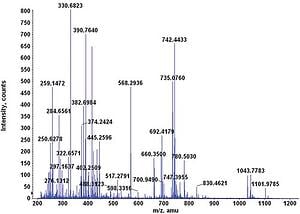 In mass spectrometry-based proteomics, nothing comes close to trypsin in breaking down protein mixtures into peptide fragments. In fact, protein researchers consider trypsin as the runaway winner when it comes to protease activity and specificity – and there are a lot of good reasons why they do.
In mass spectrometry-based proteomics, nothing comes close to trypsin in breaking down protein mixtures into peptide fragments. In fact, protein researchers consider trypsin as the runaway winner when it comes to protease activity and specificity – and there are a lot of good reasons why they do.
Why Choose Trypsin?
Researchers have high regard for the serine protease trypsin, the “workhorse” protease in proteomics, and there are several reasons behind this. For one, trypsin exhibits superior cleavage specificity. It specifically hydrolyzes peptide bonds only when the carbonyl group is followed by arginine (Arg) or lysine (Lys) amino acid residue. However, cleavage will not occur if proline is on the carboxyl side or C-terminal of lysine and arginine. This is of extreme importance since in the process of searching peptide fragmentation spectra against sequence databases, potentially matching peptide sequences should conform to tryptic specificity (i.e., cleavage exclusively C-terminal to arginine or lysine).
Interestingly enough, trypsin cleaves proteins into peptides at an average size of about 700 to 1500 Daltons, the ideal mass range for MS and tandem MS analysis. By placing the highly basic residues exclusively at the C-terminal, trypsin helps produce high mass y-ion series and makes the results of tandem mass spectra easier to interpret.
Additionally, trypsin’s popularity can also be attributed to its high protease activity, aggressive nature and unfaltering stability under a wide range of conditions.
Trypsin is quite versatile and can be used in numerous applications, which may include the following:
- Development of cell and tissue culture protocol
- Protein identification through peptide sequencing techniques
- For dissociating dissected cells prior to cell fixing and sorting
- Dissolving blood clots in microbial form
- Treating inflammation in pancreatic form
- Food processing (e.g., a baking enzyme, meat tenderizer, production of hypoallergenic food, etc.)
Understanding the Limitations
While trypsin provides excellent results when used for peptide generation, it has several limitations, including its susceptibility to autolysis and the risk of incomplete digestion.
Trypsin Autolysis
Since trypsin is also a protein, there is a risk that it may undergo autolysis or autodigestion. When native trypsin is autolyzed, it is converted to pseudotrypsin and starts exhibiting broader proteolytic activity. To make matters worse, the autodigestion of trypsin produces trypsin fragments which may have a negative effect on sequence analysis.
However, you won’t run into this problem if you are using mass spectrometry grade trypsin. MS grade trypsin has undergone chemical methylation to generate an enzymatically active protein with extreme resistance to autolysis and maximum specificity. It has also been treated with tosyl phenylalanyl chloromethyl ketone (TPCK), a protease inhibitor that hinders the activity of chymotrypsin, to prevent chymotrysin from contaminating your trypsin and compromising its cleavage specificity.
Moreover, MS grade trypsin is stable at ambient temperature, can maintain its activity in severe denaturing conditions and can be stored for long periods without any loss of activity.
Incomplete Digestion
While trypsin is the protease of choice for peptide generation, there is no guarantee that all the trypsin sites in your protein will be fully digested. Typically, you can be left with 10% to 30% undigested trypsin sites, with the majority occurring at lysine sites. To increase efficiency without affecting the structure of digestion products, supplement your trypsin with Lysine-C at a ratio of 1:100 to 1:20 (enzyme to protein ratio, by weight) in standard digestion buffer. This combination is proven to give better cleavage at the lysines sites than when using trypsin alone.
Incomplete digestion may also result from protein folding since it limits trypsin’s access to potential cleavage sites. This is a common problem when working with hydrophobic proteins. If this is the case, try using an MS-compatible surfactant to relax the protein structure and improve protein digestion.






